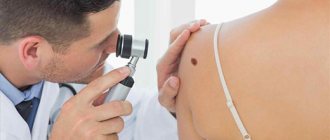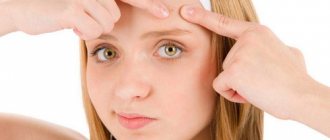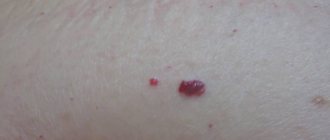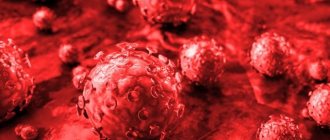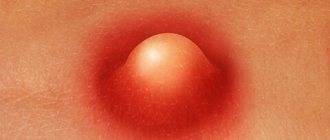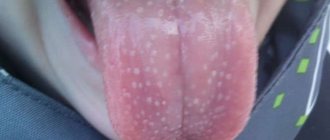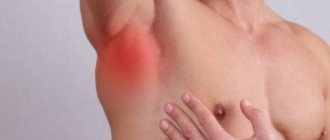What causes boils on the body
The following reasons for the appearance of boils on the body are distinguished:
- decrease in the body's defenses;
- metabolic failure;
- poor nutrition with an excess of fried, smoked foods, as well as foods enriched with fats;
- hypothermia of the body;
- experiencing stressful situations;
- overheating of the body;
- excessive contamination of the skin due to increased work of the sweat and sebaceous glands.
The main cause of boils on the human body is Staphylococcus aureus. This type of bacteria is present on the body of over 25% of the world's population. In the presence of the above reasons, active proliferation of microorganisms occurs, which leads to the appearance of boils.
The following specific reasons for a woman are possible:
- insufficient hygiene (especially in the intimate area);
- skin injuries due to cosmetic procedures (depilation);
- hormonal imbalances (menstruation, pregnancy, adrenal diseases);
- undernutrition due to dieting.
Men may also experience boils after shaving, which cause skin damage and inflammation.
Boils can occur on any part of the human body. They often appear on the face (the area above the upper lip, nose, cheeks, forehead and area behind the ears, pinna), neck (side and back), forearms, elbows, thighs, buttocks and groin.
Symptoms
First of all, a person observes formations on his stomach, inside of which there is pus. The appearance of boils is accompanied by symptoms such as :
- high temperature without signs of a cold occurs due to intoxication;
- appearance of weakness;
- deterioration in general health;
- possible headaches;
- itching and unpleasant burning sensation in the chiria area;
- tingling under the skin;
- hardening can be felt with your fingers;
- redness of the boil and its enlargement;
- inside the formation a purulent core is visible, which has a greenish tint.
Attention! If a person experiences these symptoms, it is necessary to visit a doctor.
The difference between a boil and a regular pimple
The presence of boils on the body, unlike acne, manifests itself as unpleasant sensations. They are always present and are especially pronounced when pressing on them.
Be sure to read:
Proven methods for treating boils in the ear
Boils are accompanied by severe redness of the tissues adjacent to them. They are larger than regular pimples and mature much more slowly. If, after the pimple ripens and is squeezed out, no traces remain on the skin over time, then after removing the boil, scars often remain on the dermis .
If there is a pimple, the local temperature does not increase. With boils, it increases, and pulsation may be felt at the site of inflammation. A boil, unlike a pimple, is an already developed inflammation, the duration of which can exceed two weeks.
What does a boil on the stomach look like?
As the infection develops, the patient begins to feel itching and an unpleasant tingling sensation. Over time, the skin turns red and formation appears. As it grows, the boil acquires distinct contours and increases in size. The formation resembles a cone that rises above the skin due to the accumulation of pus inside.
As the boil develops, the patient begins to feel severe itching and pain even with a slight touch. This is accompanied by malaise. Possible increase in temperature .
At the initial stage, the growth simply resembles a red pimple on the stomach. As the disease progresses, the chirium develops a necrotic core and the growth increases in size. Then the growth opens on its own due to a large accumulation of pus, which, together with the rod, independently emerges to the surface of the skin.
A hole remains at the site of the abscess, which heals over time. A small whitish scar remains in place of the chiria.
Important! To avoid negative consequences, it is recommended to consult a doctor to effectively get rid of boils.
Next you can see photos of boils and boils.
Stages of boil maturation
The boil goes through three stages in its development:
- Infiltration . The stage lasts for 3-4 days. During this process, redness occurs on the skin. A swelling quickly increases in size, which then becomes dense. At the site of inflammation, a burning sensation appears, combined with tingling. By the end of the stage, the compaction takes the shape of a cone, and the tissue adjacent to it swells greatly.
- Purulent-necrosis stage . A pustule filled with pus forms on the surface of the seal. The pain at the site of inflammation intensifies. A person's body temperature rises. All this is accompanied by weakness and general malaise. Towards the end of the stage, the boil breaks out and the pus comes out. The wound is gradually clearing.
- Healing . The cleaned canal gradually heals. Initially, the site of inflammation acquires a red-blue tint, after which it turns pale. After 4 days, complete healing occurs with the formation of a scar.
A boil localized in the ear area manifests itself in headaches at the stage of necrosis. Temporary hearing loss may occur.
Possible complications
During the treatment of boils, it is important to follow important rules to promote a speedy recovery and prevent complications.
Removing pus on your own can lead to the spread of infections and other dangerous consequences. At the moment of suppuration, you need to forget about visiting the bathhouse, sauna, or steaming rooms for the body. In such places, the pores open, and it is easier for infections to penetrate into the deep layers of the dermis and infect the individual. An increased body temperature will only help the disease develop and spread even faster. Reproducing bacteria harm the heart, lungs, and threaten arthritis and pyelonephritis.
A boil can be contagious if the pus is not wiped away carefully and the skin is not treated with an antiseptic. The bacteria can get on the skin of another person and spread to other parts of the body. New formations will arise there.
The most terrible complication is sepsis and purulent meningitis, in such cases death is possible.
The occurrence of subcutaneous boils is a common and safe phenomenon.
You can remove boils in different ways, the main thing is not to expect it to resolve on its own. Timely disposal of the abscess will relieve dangerous complications. The article has been verified by the editors
Diagnostics
Before treating furunculosis, the dermatologist performs the following diagnostic procedures:
- visual inspection of the site of inflammation using a device (dermatoscopy);
- bacteriological culture of a boil fragment;
- carrying out a blood test.
If a patient has a lot of boils on his body, then he needs to donate blood for sugar. It is also necessary to carry out urine culture. An ultrasound of internal organs and x-rays may be required.
Be sure to read:
What ointments can be used to treat boils
The presence of complications implies the need for blood cultures to be tested for sterility. The patient may be referred for a CT scan and MRI.
Preventing boils
The problem of boils on the body is quite delicate, and their occurrence and, accordingly, treatment is not a particularly pleasant procedure.
Therefore, any person who cares about their health should think about how to avoid this disease.
The most important rule in the fight against this problem is to keep your body in good condition, and for this you need a lot:
- Follow the rules of hygiene;
- Wear only clean clothes;
- Monitor your immunity;
- Eat properly;
- At least once a year, be checked by a doctor for the manifestation of various, including chronic, diseases.
Therapy methods
Treatment of boils in the absence of complications is predominantly conservative. There are many options for treating boils on the body. The patient is prescribed a course of both systemic and local medications.
If complications occur, surgery may be required. Also, as a supplement, the patient can use folk remedies.
Medicines used
For the disease, local remedies are predominantly used. The following ointments are prescribed to get rid of boils on the body:
- Vishnevsky ointment;
- ichthyol ointment;
- "Levomekol";
- "Levomycetin".
These products have a pulling effect. They speed up the process of secretion of pus. It is recommended to use ointments at the entire stage of boil maturation. At the same time, it is necessary to regularly treat the site of inflammation with antiseptics:
- hydrogen peroxide;
- salicylic acid or alcohol;
- boric alcohol;
- "Chlorhexidine."
After cleansing the boil from pus, it is recommended to use antibacterial ointments (Bactroban, oflocaine ointment). Antibiotics for boils on the body are necessary for multiple inflammations and complications. Also, medications in the form of tablets must be taken when a boil is located on the face. Patients are prescribed the following drugs:
- "Azithromycin";
- "Ampicillin";
- "Flemoxin";
- "Ceftriaxone".
Therapy with antibacterial medications for boils on the body lasts for at least 5-7 days.
Surgery
If complications develop, the doctor may perform an operation to open the boil. This is done using a scalpel under local anesthesia. After opening the area of inflammation, pus is drained from the cavity. In the following days, the patient should treat the area with antiseptics. He is also prescribed a course of antibiotics and physical therapy.
Folk remedies
As a supplement, along with traditional treatment, patients can use the following remedies for boils on the body:
- Chamomile compress . Two large spoons of the plant are poured into 0.5 liters of boiling water, after which the mixture is infused for half an hour. It is recommended to use lotions at the stage of boil infiltration.
- Baked onion . Take a whole onion without the husk, place it in foil and bake it. Then it is crushed to a mushy state, applied to the boil, and covered with cotton wool, film and a warm cloth on top. It is recommended to use the product at night to speed up the opening of the boil.
- Aloe compress . A leaf of the plant that is cut in the middle is enough. The place from which it is released is applied to the boil. The top is covered with gauze and secured with a band-aid. Leave it overnight.
Be sure to read:
Proven methods for treating boils in the ear
Aloe juice has the following beneficial properties: antiseptic, antibacterial, anti-inflammatory, analgesic, stretching, wound healing.
It is also recommended to use castor oil . It is necessary to soak a cotton pad with it and apply it to the boil.
Diet
When treating furunculosis, it is necessary to consume more protein. It is recommended to exclude sweet and fatty foods from the diet. The basis of nutrition should be plant foods. Salt consumption is significantly reduced. It is healthy to eat chicken broth, fermented milk products, baked vegetables with meat, steamed fish and porridge with butter.
Treatment methods
In most cases, the patient is prescribed outpatient treatment. It is divided into several stages, which depend on the maturation of the boil.
Medicines
initial stage
At this stage, the patient is prescribed a course of antibacterial drugs to prevent the spread of infection. It is possible to prescribe medications such as :
- Apmicillin;
- Amoxicycline;
- Cephalexin;
- Bicillin.
Simultaneously with taking medications, chiria is treated to speed up its maturation. Treatment of the formation can be carried out with ointments :
- Ikhthylova;
- Vishnevsky;
- Sintomycinova.
If the patient feels pain, you can use Tetracycline ointment or Levomekol.
Advice! After applying the ointment, always apply a bandage, which is changed every 2 hours.
Maturation stage
The furuncle matures within 5-7 days. As soon as a purulent core is formed, it will come out of the formation. The wound is treated with saline solution.
Healing
As soon as there is no pus or plaque in the wound, you can apply dressings with Levomekol . This remedy will promote rapid wound healing and also prevent the development of inflammatory processes. You can also use Bactroban or Baneocin . To avoid the appearance of scars after the wound has healed, use Panthenol.
Surgically
The opening of the boil occurs on its own. If this does not happen, you need to contact a surgeon. He will remove the rod with tweezers and wash the wound with Furacilin or Hydrogen Peroxide. Next, the doctor applies a saline dressing to remove any remaining pus and cleanse the skin of dead tissue.
As prescribed by the doctor, the patient himself carries out dressings. For this, ichthyol ointment is used, which is applied to the wound up to 2 times a day.
ethnoscience
Traditional recipes can be used to treat a boil if it is only at the initial stage of formation.
- Bake an onion and crush it . Mix the gruel with finely grated laundry soap in a ratio of 2 to 1. Apply the mixture to the chiri and secure with a band-aid. Change the bandage once a day.
- Apply a cut aloe leaf to the formation overnight and secure it with a band-aid. Carry out the procedure until the chiria ripens.
